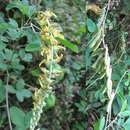en
names in breadcrumbs


Crotalaria pallida, commonly known as the smooth crotalaria, is a species of flowering plant within the family Fabaceae.[1][2]
Synonyms are Crotalaria mucronata Desc, Crotalaria striata DC, Crotalaria falcata VAHL ex DC, Crotalaria brownei DC., Crotalaria fertilis Delile, Crotalaria hookeri Arn., Crotalaria pisiformis Guill. & Perr., Crotalaria siamica F.N.Williams, Crotalaria striata var. acutifolia Trin., Crotalaria tinctoria Baill, Crotalaria zuccarininana D.Dietr.[3][1][2] The preferred common name is crotalaria, with other common names including striped rattlepod and crotalaire striée.[2]
This shrub (annual or short-lived perennial herb) has height of about 1.5 m. The stout stem is hairy and has longitudinal grooves. Leaves are trifoliate with a 2-8.5 cm long petiole, leaflets 3-13 x 2–5 cm and elliptical to obovate. Flowers are yellow, often reddish-brown veined and borne on 15–40 cm long racemes, each with 20-30 flowers. Fruits are 3-5 x 0.6-0.8 cm, 30-40 seeded that are heart-shaped, 3 x 2 mm, shiny, mottled ochre and dark grey-green or brown.[4]
Crotalaria pallida is found in Indonesia, Sudan, Florida, Puerto Rico, and Brazil.[2] India, Bangladesh
The plant is grown as a ground cover and a green manure crop, especially in the inter-rows of rubber trees and coconut palms. Flowers are eaten as a vegetable in Cambodia, where the seeds are roasted and grounded for use as a sort of coffee beverage. The roots are sometimes chewed with betel nuts in Vietnam. In traditional medicine, the plant is used to treat urinary problems and fever, a poultice of the roots is applied to swelling of joints and an extract of the leaves is taken to expel intestinal worms.[4][5]
Crotalaria mucronata Desv was reported to be widely used in the southern part of the U.S.A. as a green manure crop under the name “giant striata”.
Crotalaria pallida, commonly known as the smooth crotalaria, is a species of flowering plant within the family Fabaceae.